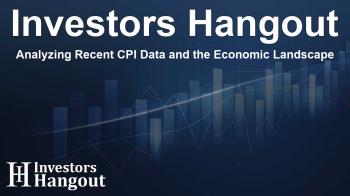Analyzing Recent CPI Data and the Economic Landscape

Navigating the Latest CPI Data and Market Impacts
As we transition into 2025, we find ourselves grappling with unexpected shifts in inflation metrics. The focus has intensified on consumer price index (CPI) data, which reflects the economic environment's volatility. Echoing last month's observations, January data continues to show irregularities that warrant careful interpretation.
Understanding CPI Trends
The recent CPI readings have sparked interest, especially with a headline increase that defied initial expectations. Specifically, we saw headline CPI rising by a notable 0.47% and core CPI climbing by 0.45%. These figures are significant, marking some of the highest levels we've experienced since early 2023.
Key Factors Influencing CPI
Several elements contributed to these elevated numbers. For instance, used car prices increased by 2.19% month-over-month, showcasing a considerable jump. This uptick, however, raises questions regarding the ongoing adjustments in consumer vehicle costs that arose during the COVID-19 pandemic. The inflation rates for certain goods, such as pharmaceuticals, also rose dramatically—experiencing a monthly increase of 1.4%, the largest in several years.
Contextualizing Inflation with Historical Comparisons
When we compare current inflation data to historical contexts, it’s important to remember that prior to the pandemic, we hadn’t seen core CPI numbers soaring as high as today since 1992. This perspective helps underscore the severity of the current situation and the potential long-term implications on the economy and consumer behaviors.
The Role of Tariffs in Economic Measures
In the backdrop of these CPI fluctuations, tariffs play a pivotal role. Recent discussions have highlighted how increasing tariffs might affect inflation across various sectors, particularly if they are uniformly applied. Historically, tariff increments lead to short-term price escalations, yet their overall impact on monthly inflation figures remains complex and often mitigated by other economic factors at play.
Evaluating Consumer Goods Impact
It’s crucial to focus on core goods, which recently dipped slightly but still present challenges for maintaining lower inflation rates. The current environment necessitates that core goods inflation remains significantly subdued to help achieve the target inflation rate of around 2%. As we analyze these changes, monitoring the balance between goods and services inflation helps provide a clearer perspective on future economic stability.
Health Insurance and Lodging Price Trends
Certain categories within CPI have shown interesting trends as well. Health insurance spikes, while not entirely unusual for the start of the year, deserve attention as they may signal broader inflationary pressures. The lodging sector, influenced by factors like natural disasters and housing shortages, has buoyed pricing trends that could persist throughout the year.
Long-term Economic Predictions
Looking ahead, the trajectory of inflation suggests a likely stasis in the high 3s to low 4s percentage ranges. Several economic indicators, such as the M2 money supply growth, hint at an inflationary environment that may surpass recent benchmarks unless substantial shifts occur in the economic landscape. Despite concerns, should tariffs be incrementally implemented, the expected inflation could result primarily from these short-lived economic disruptions.
Conclusion on Inflationary Trends
The economic landscape remains unpredictable, with inflation projections reflecting the delicate balance of supply chain dynamics, consumer behavior, and global market shifts. As we journey further into 2025, it will be vital to keep a close watch on how various factors—especially tariffs and the broader money supply—interact to shape economic realities for consumers in the coming months.
Frequently Asked Questions
What does CPI stand for and why is it important?
CPI stands for Consumer Price Index, and it measures the average change over time in the prices paid by consumers for a basket of goods and services. It’s a critical indicator of inflation and economic health.
How do tariffs influence inflation rates?
Tariffs can lead to increased prices for imported goods, which can, in turn, raise overall inflation rates, especially if widely implemented.
Why are used car prices significant in CPI calculations?
Used car prices often reflect broader economic conditions, as significant changes can indicate shifts in consumer spending and supply chain issues directly affecting inflation metrics.
What might be the impact of rising health insurance costs?
Increases in health insurance can signify underlying inflation pressures in the health sector, potentially affecting overall consumer costs and CPI measurements ahead.
What is the expected inflation rate for the coming years?
Analysts predict a likely inflation rate in the high 3s to low 4s in the near term as the economy adjusts to various influencing factors, including tariffs and changes in monetary policy.
About The Author
Contact Logan Wright privately here. Or send an email with ATTN: Logan Wright as the subject to contact@investorshangout.com.
About Investors Hangout
Investors Hangout is a leading online stock forum for financial discussion and learning, offering a wide range of free tools and resources. It draws in traders of all levels, who exchange market knowledge, investigate trading tactics, and keep an eye on industry developments in real time. Featuring financial articles, stock message boards, quotes, charts, company profiles, and live news updates. Through cooperative learning and a wealth of informational resources, it helps users from novices creating their first portfolios to experts honing their techniques. Join Investors Hangout today: https://investorshangout.com/
The content of this article is based on factual, publicly available information and does not represent legal, financial, or investment advice. Investors Hangout does not offer financial advice, and the author is not a licensed financial advisor. Consult a qualified advisor before making any financial or investment decisions based on this article. This article should not be considered advice to purchase, sell, or hold any securities or other investments. If any of the material provided here is inaccurate, please contact us for corrections.

